- The Africa Brief
- Posts
- Africa in Brief - November 21, 2025
Africa in Brief - November 21, 2025
40% Mobile Money | 13x Fintech Growth | Cedi Up 34% + Gabon’s Eco Promise
Hello from Kigali, where the air is crisp, the hills are green and Norrsken Africa Week has the whole city humming. After several days of focused leadership meetings for Renew Capital, I dug into the continent’s stories and found a lot that piqued my curiosity: digital finance is rewriting the rules, fintechs are leveling up, central banks are easing off the brakes and Gabon of all places is quietly showing off one of the planet’s last true Edens. Let’s dive in.
Africa Trivia
Known in the past as South West Africa, which country embraced a new name and identity?
A) Botswana
B) Namibia
C) Zambia
D) Zimbabwe
Graphic of the Week
Beyond Brick Banks
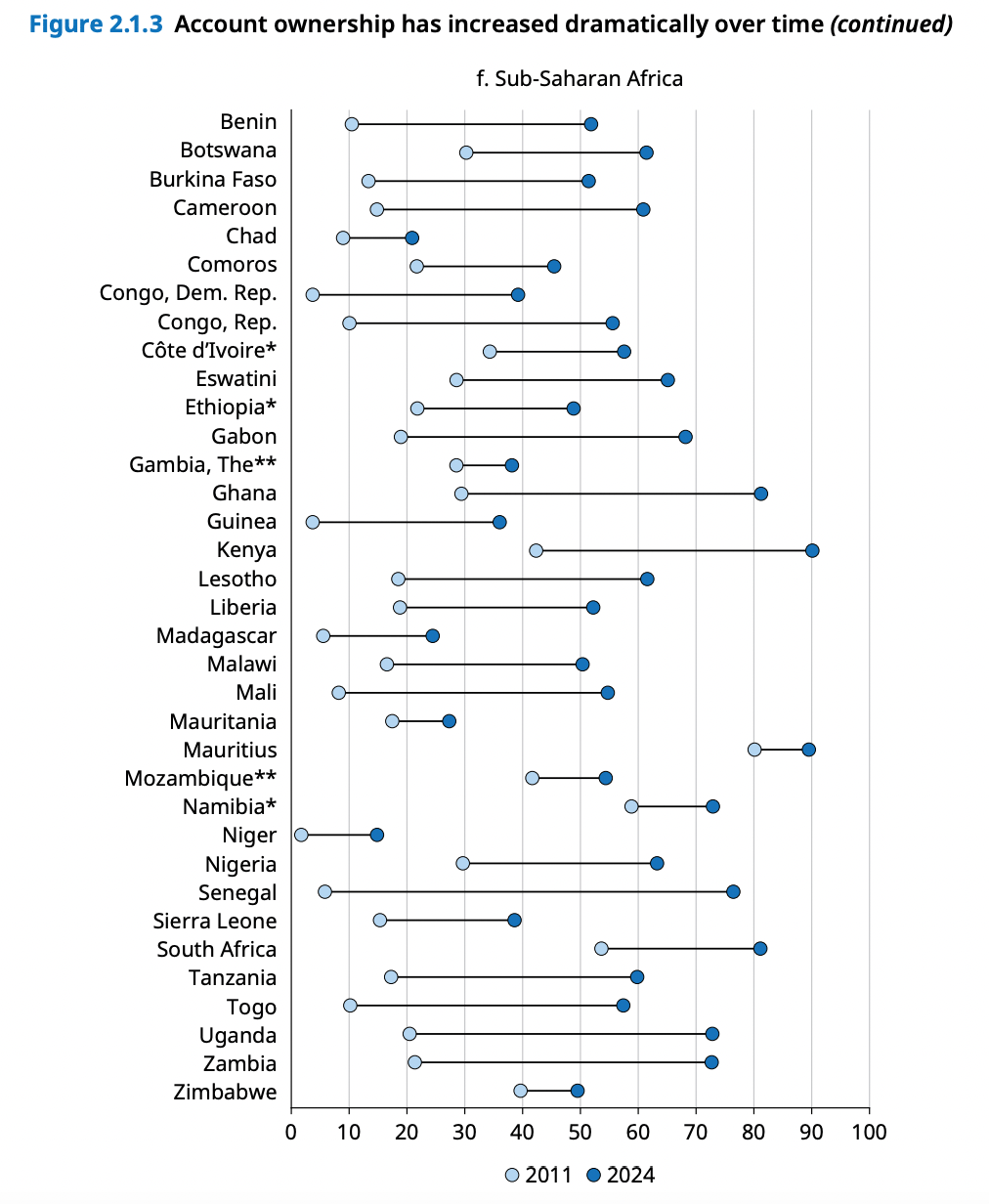
Source: World Bank
I wanted to dig a little deeper on financial inclusion in Africa, so I bring you back to the World Bank’s Global Findex 2025 Report. The data show Africa racing toward digital finance and that mobile technology, not traditional banks, is now the main driver of financial inclusion across much of the continent.
The Landscape:
What counts now: An “account” includes bank accounts and mobile money wallets recognized by the GSMA, the global body for mobile operators. If people can store money and send or receive payments, it qualifies.
Two rails driving access:
Bank rails: Accounts at regulated institutions plus anyone with a linked debit card.
Mobile money rails: Phone-based wallets on GSMA-tracked platforms used to pay, get paid or move money in the past year.
Access is exploding: Global account ownership jumped from 51% in 2011 to 79% in 2024. In low- and middle-income economies, it rose from 42% to 75%, with digital channels doing the heavy lifting.
Mobile money’s global boom: Up from 2% of adults in 2014 to 15% globally and 18% in low- and middle-income economies as of 2024.
Africa leads the leap: About 40% of adults in sub-Saharan Africa have a mobile money account. In 19 countries, more people rely only on mobile money than on banks.
Digital is the new default: Nearly half of adults in low- and middle-income economies now have a digitally enabled account through mobile money or bank cards/apps.
Gaps persist: Women, poorer households, young adults, rural residents and those with less education remain less likely to be banked, even as some gaps narrow.
1.3 billion still out: Despite massive gains, the world still has 1.3 billion unbanked adults, the next frontier for digital inclusion.
Africa’s story is clear and exceptional: Digital rails are doing what physical banks couldn’t and accelerating financial inclusion at scale. The next challenge is reaching the last mile, the women, youth and rural communities who remain locked out of the formal system. Read more: World Bank’s Global Findex 2025 Report.
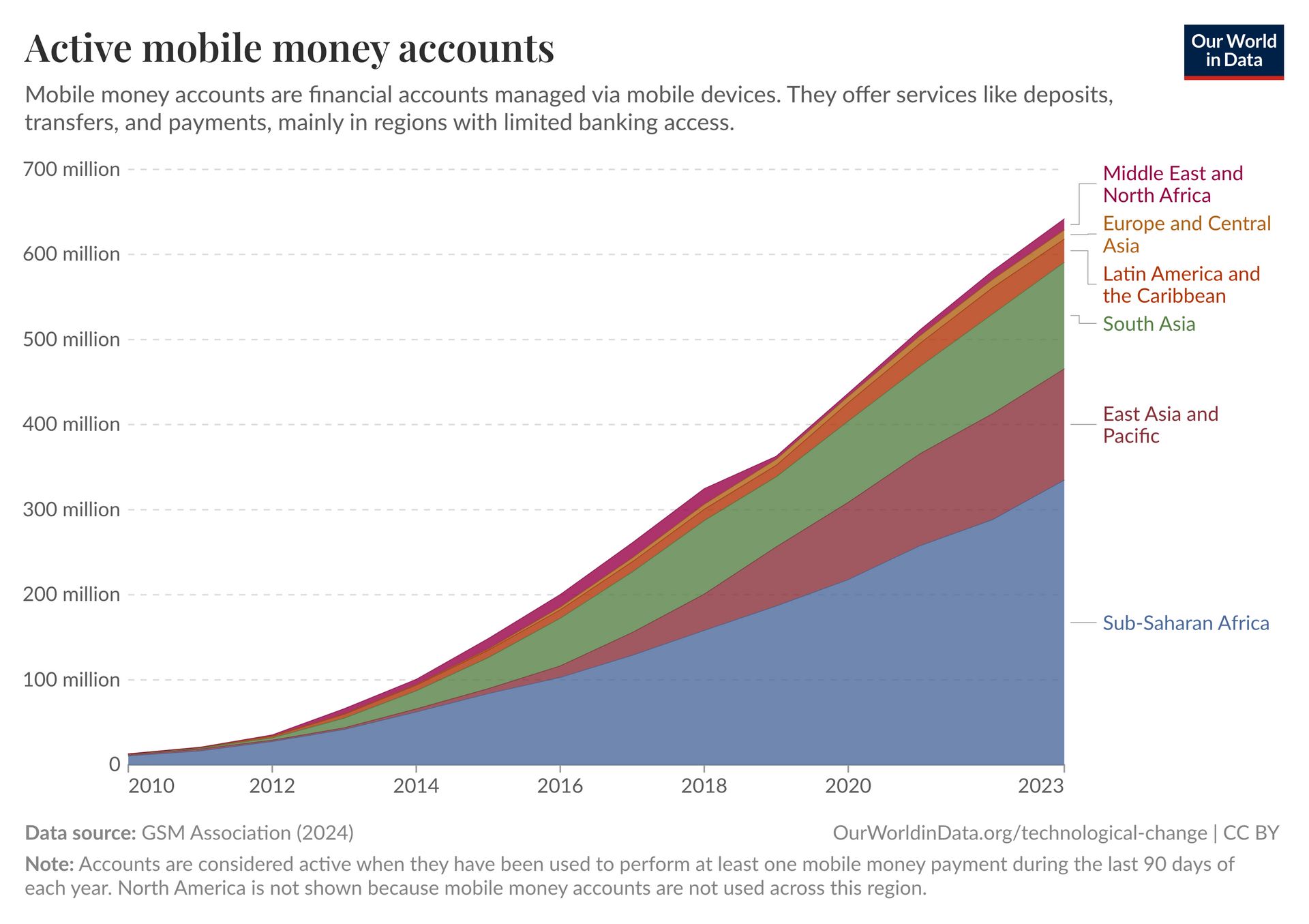
Source: Our World in Data
What We Are Reading
Africa: The EU debated establishing migrant return hubs in “safe” African countries as part of a broader push to manage rising arrivals from North Africa (Reuters).
Algeria rejected Spain’s request to reopen the Maghreb gas pipeline, closed in 2021, over Morocco’s Autonomy Plan support (Morocco World News).
Angolan government announced it will speed up mining permits, cut bureaucracy and improve transparency to attract investment in the minerals sector (Bloomberg).
DR Congo: At least 32 were killed after a makeshift bridge collapsed at an unauthorized cobalt mine amid a rush of miners (BBC Africa).
Egypt: Inflation rose to 12.5% in October, creating uncertainty over the next interest-rate cut (Bloomberg).
Ethiopia confirmed its first Marburg virus outbreak with nine cases in the southern Omo region and the WHO praised the rapid government response (AP News).
Eswatini confirmed receiving $5.1M from the U.S. for accepting deportees as part of the Trump administration’s immigration policy (BBC Africa).
Ghana announced it will remove VAT on minerals processing to encourage investment and support economic growth (Semafor).
Kenya: President Ruto used his State of the Nation address to declare that the country has moved from crisis to stability, citing falling inflation, a steady shilling, record reserves, a successful Eurobond repayment and a jump to Africa’s sixth-largest economy as evidence of a broad macroeconomic turnaround (Dawan Africa).
Libya’s rival eastern and western legislatures signed a deal for a unified development program, a rare step toward merging their long-divided finances after more than a decade of split budgets, the central bank said (Reuters).
Morocco surpassed its high-tech manufacturing target 11 years early with advanced industries generating more than 50% of industrial added value (Morocco World News).
Mozambique: On November 18, the government approved the restart of the Mozambique LNG – Area 1 project in Cabo Delgado, led by TotalEnergies, after a suspension since 2021 (360 Mozambique).
Nigeria: Foreign reserves hit $46.7B, the highest since 2018, supported by investor confidence, oil receipts and S&P positive outlook (Nairametrics); President Tinubu postponed his planned G-20 trip to address a surge in violent attacks at home (Bloomberg).
Rwanda began construction of a $24M biosafety level three (BSL-3) lab to detect and respond to animal and zoonotic diseases (New Times Rwanda); ALX launched ‘Chidi’, an AI mentor guiding students to think critically and learn independently across Africa (New Times Rwanda).
South Africa hosted the first G20 in Africa, urging rich countries to increase climate disaster support for underdeveloped nations (AP News); President Ramaphosa opened Ivanhoe’s Platreef mine, starting production of platinum-group metals with plans to expand output to 450,000 ounces annually by 2028 (Bloomberg).
Togo: President Gnassingbé met President Putin in Moscow for talks focused on expanding cooperation as Russia deepens its influence in Africa (Reuters).
Tanzania: President Hassan appointed her daughter, Wamu Hafidh Ameir and former President Kikwete’s son, Ridhiwani Kikwete to new cabinet positions (Citizen Digital); President Hassan said the country may struggle to secure international funding due to its damaged global image after the disputed election (Reuters).
Uganda said three-quarters of its $5B heated crude pipeline to Tanzania is complete as it targets first oil production next year (Reuters).
Zambia announced that it will host a Chinese premier for the first time in 28 years to strengthen ties and secure commodity access as Zambia emerges from its debt crisis (Reuters).
Zimbabwe: The dollar-only Victoria Falls Stock Exchange is rapidly gaining ground and could surpass the main bourse within two years, as market value and liquidity surge (Bloomberg).
Innovation in Africa
New Rails Rising
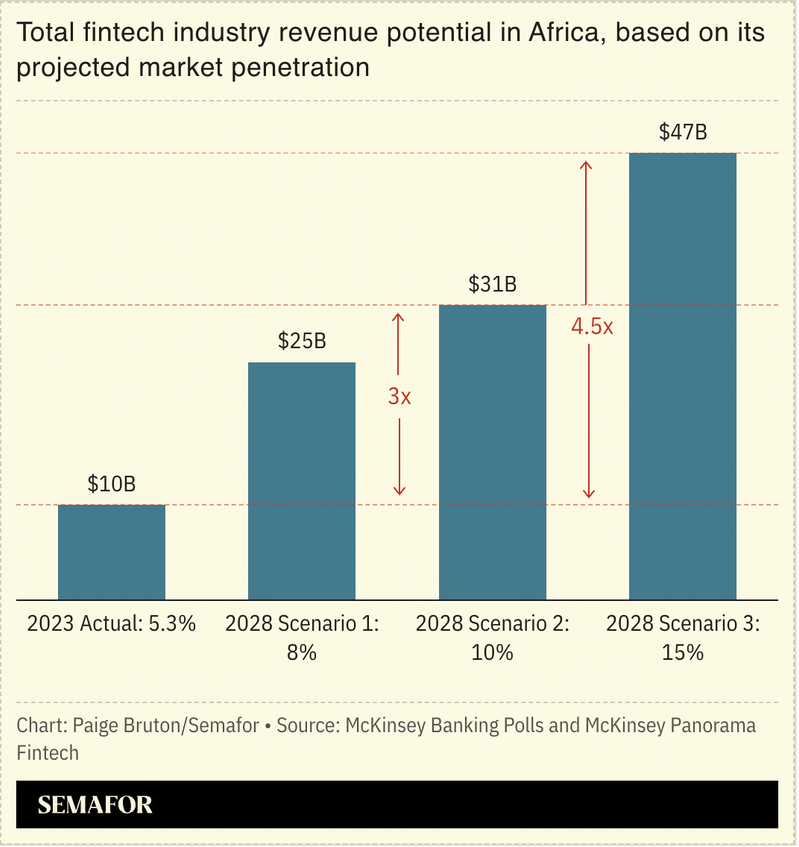
Source: Semafor
African fintechs are entering a new phase: broader products, bigger footprints and a push to become everyday financial platforms. PalmPay now offers health insurance in Nigeria, with one million enrollees since 2024. Wave is exploring loan partnerships across West Africa. Egypt’s MNT-Halan now lets customers tap instant credit against investments and is eyeing the Gulf.
Older players are scaling too. Paga launched dollar accounts for U.S. users. PalmPay moved into Tanzania and Bangladesh; Wave expanded into Cameroon, bringing its reach to nine African countries.
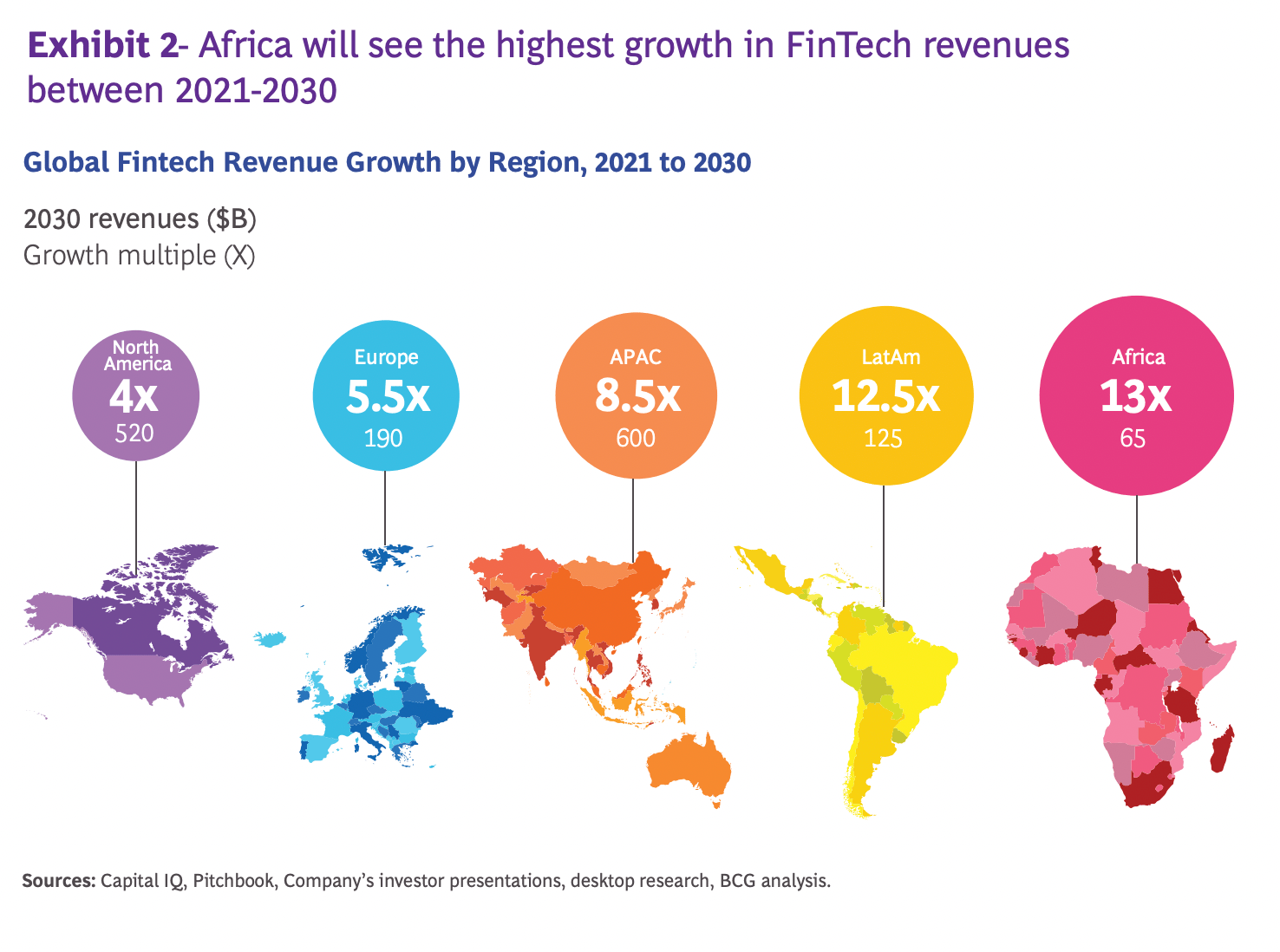
Source: BCG
BCG’s 2023 report (a bit dated) explains the structural drivers: Africa remains the world’s fastest-growing fintech market, with revenues projected to rise 13x between 2021 and 2030. Yet the ecosystem is still early: ~80% of all African fintech rounds from 2018–2023 H1 were seed or angel and only 4% of startups reached Series C or later. Scale is the mandate.
Structural gaps remain large. As of 2022, about 90% of Africa’s payments were still cash (vs 56% globally). Credit penetration was 37% of GDP (vs 145% globally). Insurance penetration was roughly half the global average. These gaps are exactly what today’s startups are targeting as they expand across borders and diversify into lending, insurance and savings.
Investors say the sector is far from saturated. Africans still have access to far fewer financial products than consumers in developed markets. What wins new markets is trust, reliability and services built for local behavior.
Key Stats
African fintech revenues could reach $47B by 2028 (McKinsey).
PalmPay health insurance: one million users since 2024.
Wave operates in nine African countries.
African fintech companies tripled from 2020 to 2024 (EIB).
~80% of African fintech rounds (2018–2023 H1) were seed/angel (BCG).
Moniepoint raised $90M to expand remittances.
Why It Matters
Africa’s financial market is still wide open. Fintechs that earn trust, solve real gaps and scale across borders can capture massive demand and drive the next decade of financial inclusion and intra-African commerce.
Read More: Semafor: African fintech players seek new growth paths; BCG (2023): Unlocking the Fintech Potential in Africa.
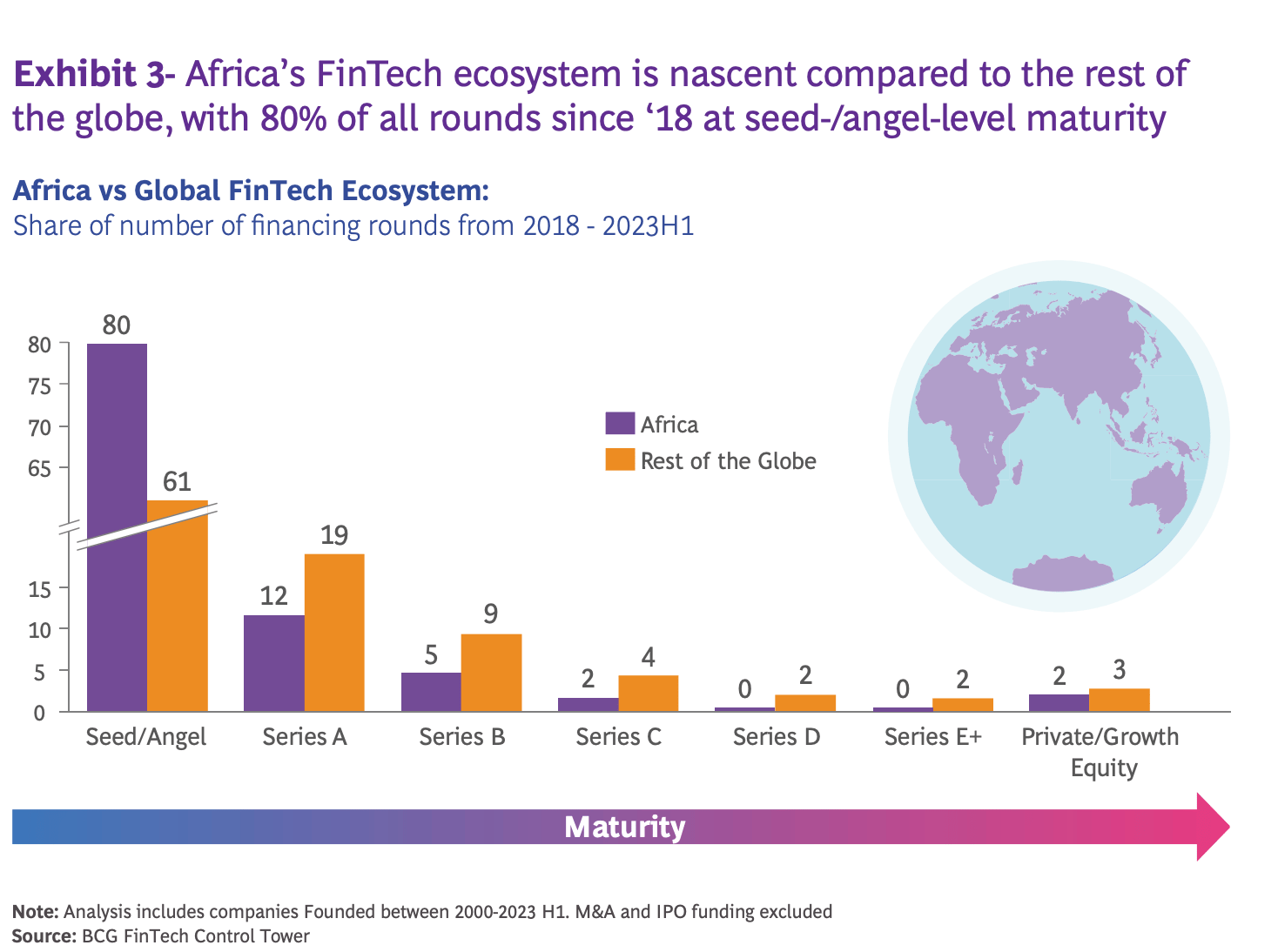
Source: BCG
Business & Finance in Africa
Rate Cut Season
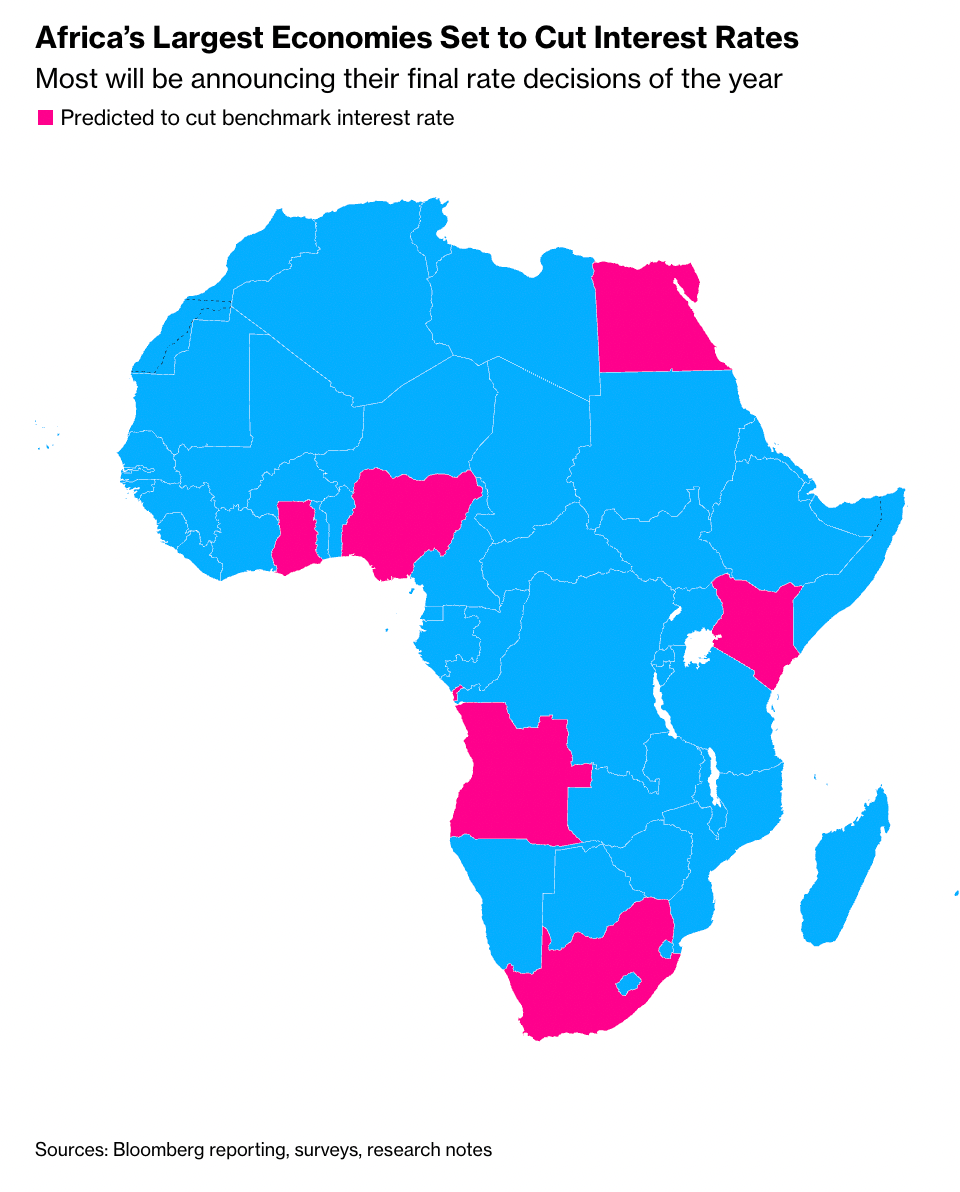
Source: Bloomberg
African central banks are lining up year-end rate cuts as inflation finally cools, setting the stage for a rare, continent-wide easing cycle.
What’s Shifting?
Cooling prices: A softer dollar, cheaper oil and easing food costs have pulled inflation down across much of Africa.
Policy turn: Zambia and the DRC already cut for the first time in years. Now bigger players like Egypt, Ghana, Angola, South Africa, Kenya and Nigeria are in the process of following.
Momentum into 2026: Oxford Economics expects cuts to continue next year, especially in Ghana, Kenya and Nigeria.
Who’s Moving Now?
Ghana: Inflation at a four-year low; another 325 bps cut expected to reach 18.25%. Cocoa and gold windfalls buoyed the cedi, now up 34% this year.
Kenya: Set to trim 25 bps to 9%, extending its longest easing streak on record.
Nigeria: Inflation eased to 16%, a three-year low; the central bank has room to loosen again.
Angola: Inflation slowed to 17.4% and the central bank cut the policy rate by 50 bps to 18.5%. Economists had previously projected a 50 bps move, which is now reflected in the new rate (Trading Economics).
South Africa: Treasury backing a 3% inflation target strengthens expectations for a 25 bps cut. South African Reserve Bank cut its key policy rate by 25 bps to 6.75% on November 20, 2025 (Reuters).
Egypt: Economists split after a rent-driven inflation bump; forecasts range from no change to a 100 bps cut.
Smaller economies? Lesotho, Namibia, Botswana set to follow.
Why This Moment Matters
A synchronized easing cycle is rare in Africa. Lower rates could revive lending, ease budget pressure and support fragile recoveries after years of inflation shocks and tight monetary policy. Stronger currencies, from the cedi to the naira, are helping central banks pivot from firefighting to growth. Read more: Bloomberg.
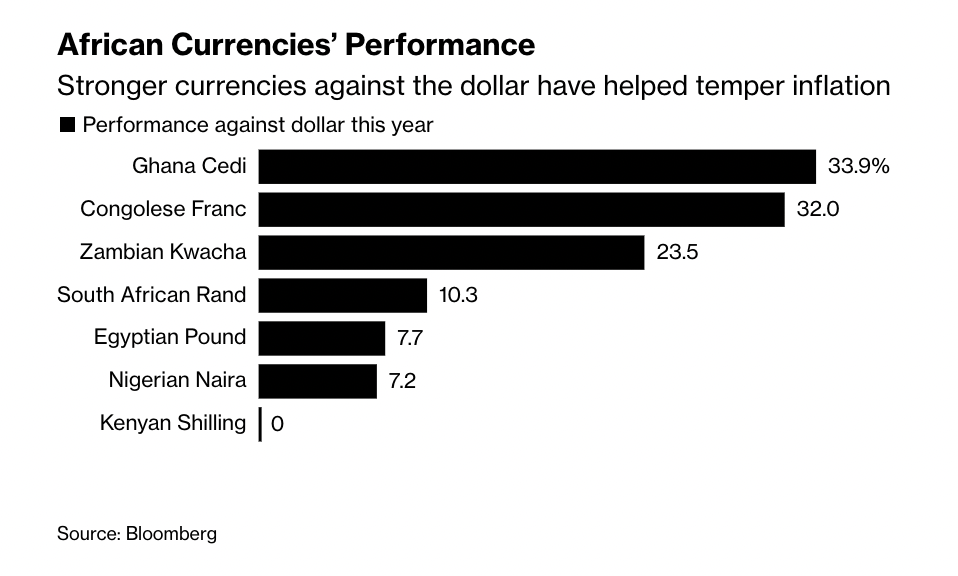
Source: Bloomberg
Explorations in Africa
Gabon: An Untouched Eden

Source: FT
An immersive FT journey tracks deep into Gabon’s rainforests, revealing one of Africa’s wildest, least-touched frontiers. I shall put Gabon on my list.
The Landscape:
A living time capsule: Gabon is 88% rainforest, among the oldest on Earth, thick with okoumé, ceiba giants and liana vines as thick as ship ropes.
Megafauna refuge: About 95,000 forest elephants live here, roughly 65% of the world’s total, alongside lowland gorillas, 1,000-strong mandrill troops and 659 bird species.
Raw access: Only 40,000 visitors a year reach Gabon due to punishing roads, limited lodges and remote parks accessible only with researchers and trackers.
Protected wilderness: Thirteen national parks cover 10% of the country, no hunting allowed, making animal encounters unusually intimate and uncommercialized.
Why It Matters: Gabon’s intact ecosystems and strict conservation regime make it a potential world-class eco-tourism hotspot. If stability holds and access improves, the country could anchor Central Africa’s high-end nature tourism economy. Read more about Gabon’s ecotourism potential in FT.

Source: Financial Times
Africa Trivia Answer
Answer: B. Namibia - Formerly known as South West Africa, the territory embraced a new name and identity as Namibia and on March 21, 1990, it achieved full independence from South Africa after a long UN-supervised process of decolonization. Source: UN-ilibrary.org, Wikipedia.
Thanks for reading. If you missed it, last week’s graphic focused on Compute is power. If you have a topic you want us to dig into, email us at [email protected] and thanks for all the shares and support. See you next week!
Reply